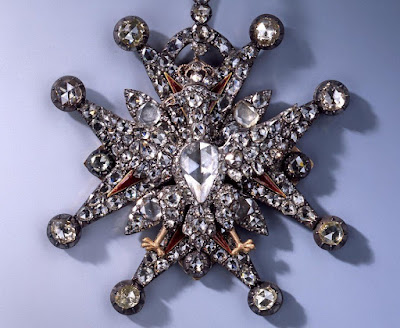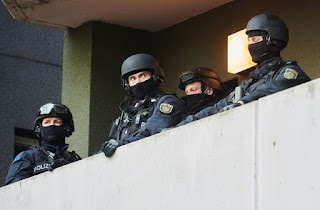The jewels survived Allied bombing raids in WW2 but were apparently seized by Red Army soldiers as war booty. The precious jewels were returned to the Dresden Museum in 1958, and kept in display cases. Then there was extensive renovation and restoration work in 2006.
Dresden Grünes Gewölbe-Green Vault
beautiful displays behind glass windows, BBC
In Nov 2019 the Dresden robbers must have prepared, unnoticed, a week beforehand; they used a hydraulic bolt-cutter to slice a hole in a window-grate that they then glued together to disguise the break. The suspects set fire to a power distribution box near the Museum to plunge the streets and gardens into darkness before the break-in.
The robbers sawed through iron bars to gain entry to the display room as seen by the security camera. The footage showed 2 men entering the room, waving their flashlights across the black-and-white-tiled floor. They then shattered a glass display case with an axe before grabbing the 21 pieces of diamond encrusted jewellery, armed with a loaded revolver and an automatic loading gun and silencer. The items they took included an epaulette, rapier, shoe buckles, hat pin, brooches, a Polish Order of the White Eagle gem, large diamond rose and several skirt buttons.
Brooches, top one displaying the Polish Order of the White Eagle
beautiful displays behind glass windows, BBC
In Nov 2019 the Dresden robbers must have prepared, unnoticed, a week beforehand; they used a hydraulic bolt-cutter to slice a hole in a window-grate that they then glued together to disguise the break. The suspects set fire to a power distribution box near the Museum to plunge the streets and gardens into darkness before the break-in.
The robbers sawed through iron bars to gain entry to the display room as seen by the security camera. The footage showed 2 men entering the room, waving their flashlights across the black-and-white-tiled floor. They then shattered a glass display case with an axe before grabbing the 21 pieces of diamond encrusted jewellery, armed with a loaded revolver and an automatic loading gun and silencer. The items they took included an epaulette, rapier, shoe buckles, hat pin, brooches, a Polish Order of the White Eagle gem, large diamond rose and several skirt buttons.
BBC
After a year-long investigation by 40 officers, 3 suspects were arrested after police raided 18 Berlin properties. Two brothers were caught in Dec 2020-Feb 2021, and the third suspect was arrested in summer 2021. Prosecutors are still investigating 40 others in relation to the heist, including four men who are suspected of entering the museum disguised as tourists. The fake tourists’ role was to gather strategic information about security, layout and personnel.
Some of the accused German nationals, aged in their mid 20s, will be tried in a juvenile court, as two of them were legally minors at the time of the heist. All of the accused were charged with being gang members involved in gang robbery and aggravated arson.
Armed police officers are standing on a balcony during a raid in Berlin
November 2021, art net news
Trial
Two of the Green Vault suspects now on trial were already sentenced to 4.5 years in gaol for their 2017 involvement in the 100kg gold coin worth $4.22 million, stealing it from Berlin’s Bode Museum. This had been another crime that shook Germany.
The trial of six men started in Dresden’s district court amid tight security. The defendants, all brothers and cousins aged in their mid 20s, appeared in court, handcuffed and with face covers. Proceedings are being held in, until Oct, where the men sit behind security glass.
In accordance with German judicial practice, the defendants have been referred only by their surname’s initial, R. But police had said that the suspects were members of the Remmo Clan, a family infamous for its ties to organised crime, a Berlin clan consisting of 10 families. Four other men were under investigation on suspicion of aiding and abetting, in this crime.
Did the robbers have help from insiders at the museum? Evidence suggests the robbers were aware of parts of the museum that security cameras were unable to detect.
There is a realist fear that the art objects have been broken up so that the sale of individual diamonds could go ahead, undetected by the auction houses. Yet it is possible that publicity surrounding the trial could raise awareness among people in the diamond trade who might be invited to buy them. Authorities initially offered reward of $570,000 to anyone who would lead police to the jewellery’s whereabouts. That was later raised to $1.71 million, after a private initiative to collect donations. The defendants have so far refused to give answers.
November 2021, art net news
Trial
Two of the Green Vault suspects now on trial were already sentenced to 4.5 years in gaol for their 2017 involvement in the 100kg gold coin worth $4.22 million, stealing it from Berlin’s Bode Museum. This had been another crime that shook Germany.
The trial of six men started in Dresden’s district court amid tight security. The defendants, all brothers and cousins aged in their mid 20s, appeared in court, handcuffed and with face covers. Proceedings are being held in, until Oct, where the men sit behind security glass.
In accordance with German judicial practice, the defendants have been referred only by their surname’s initial, R. But police had said that the suspects were members of the Remmo Clan, a family infamous for its ties to organised crime, a Berlin clan consisting of 10 families. Four other men were under investigation on suspicion of aiding and abetting, in this crime.
Did the robbers have help from insiders at the museum? Evidence suggests the robbers were aware of parts of the museum that security cameras were unable to detect.
There is a realist fear that the art objects have been broken up so that the sale of individual diamonds could go ahead, undetected by the auction houses. Yet it is possible that publicity surrounding the trial could raise awareness among people in the diamond trade who might be invited to buy them. Authorities initially offered reward of $570,000 to anyone who would lead police to the jewellery’s whereabouts. That was later raised to $1.71 million, after a private initiative to collect donations. The defendants have so far refused to give answers.
The heist was described as the biggest in modern German history
so security at court had to be tight. DW
The trial, involving 14 defence lawyers from across Germany, three prosecutors and representatives of the juvenile court (because of the age of two twin brothers at the time of the crime), is expected to continue at least until late Oct. Read Daily Art Magazine
so security at court had to be tight. DW
The trial, involving 14 defence lawyers from across Germany, three prosecutors and representatives of the juvenile court (because of the age of two twin brothers at the time of the crime), is expected to continue at least until late Oct. Read Daily Art Magazine





































.jpg)
















10 comments:
Hello Hels, This sounds like the plot of several movies. I am also wondering about the security system of these museums, which seems incredibly lax. There is need for extra-strong security for these objects, because they are small and easily taken, and also art robberies can be motivated politically as well as for money. The valuable diamonds and stones should also have been examined and photographed internally for their micro-flaws and inclusions, so they could still be identified even if taken apart or re-cut.
--Jim
I don't understand, Hels. Dresden Vault has the most valuable diamonds in Europe and yet pimply adolescent boys can beat the security system easily?
Parnassus
The Green Vault had such unique and valuable art objects that they MUST have known they were targets! Just the jewels that the thieves took, a TINY proportion of the priceless collection, were worth $135 million. Note the the 49-carat Dresden White Diamond alone! So I now wonder if you may be spot on re art robberies being motivated by considerations other than money eg politically or historically. The Poles, Russians, French and others may still be upset. One last thought. The Green Vault's 41-carat Dresden Green Diamond was loaned to New York’s Met Museum of Art when the break-in occurred and wasn't stolen. The thieves didn't know the green diamond was on tour? Ha!
Deb
The Staatliche Kunstsammlungen/State Art Collections Dresden include 15 of the best museums in Europe. They offer an exceptional thematic diversity, and set state standards for the art objects, curatorship and security. So did Green Vault pass the security standards, or did it fail the state's security standards and no action was taken? Or did the thieves have secret help from museum staff?
Boa tarde. Não conhecia essa história. Parabéns pelo seu trabalho excelente e pesquisa.
Wow what a story . Well I am glad it didn't result in a shootup with people dying after all when its all said and done they are just rocks !!
Luiz
and the story continues. I suspect the court cases will continue and will reveal even more extraordinary information. But I can't see the jewels being returned.
mem
I am not even remotely a conspiracy theorist, but too many factors came together in this heist to not shake the head in wonder. eg1 the robbers planned in advance, and carefully set fire to a power distribution box near the museum, to make the area dark. eg2 they brought and used a hydraulic bolt-cutter to slice open the window-grate. eg3 one of the men set fire to a car in the underground carpark, blocking the police's entrance. eg4 the robbers knew in advance where the security cameras were and covered them up. And eg5 they came fully armed.
Of all the precious objects in the museum, note they carefully selected in advance which ones the men would steal!!
Hi Hels - it was an extraordinary heist ... and such a pity so many stunning jewels and artefacts were stolen. I remember reading about it, and seeing information on the BBC ... thanks for this post - all the best - Hilary
Hilary
After a few years of blogging, I found SO MANY stolen art objects that I added a key word covering the paintings, sculptures etc that disappeared out of galleries or private spaces.
Sometimes the thefts represented war booty that had to be fought out in court, decades later. eg The Monuments Men. And sometimes loved public treasures were stolen eg the Isabella Stewart Gardner Museum heist of 1990. So I thought there was no new story to hear. But the Green Vault heist took everyone's breath away. The value of the stolen jewellery was greater than the Gross Domestic Product of many small nations.
Post a Comment